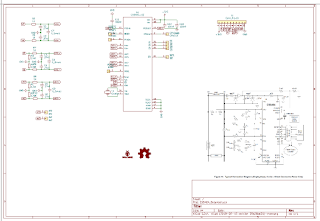Getting away from a fast paced
start-up to attend conferences is a hard ask. However I managed to get away for a few days to attend the inaugural KiCad conference in Chicago a few weeks ago.
The pace has been such that only after about a month I am getting a chance to write it all up. The first night I managed to attend the
Hardware Happy Hour at the Ballast Point. I got to see some amazing stuff including pneumatics for an autoplaying piano using layers of PCB.
The huge selection of beers and the chicago dogs were definitely unexpected bonuses.
Tour of
MHub assembly area with pick and place machine and large Molex sign. Also got to see
Chris Gammell's desk and pick up some Amazon and Mouser shopping to bring back to Nairobi.
I could definitely use the pick-n-place machine in my house and I hope Chris makes use of it whenever he can.
I also got to speak to some companies I have worked with remotely but not met the principles and representatives in person, including
CrowdSupply,
Aisler,
SnapEDA,
Hologram and of course DigiKey. It was great to speak to the KiCAD dev team as well, perhaps I can contribute on the
MSVC windows native build. I also managed to score credits freebies from all the sources.
Here are pure notes to self on various topics that I picked up on 2-days of super varied and dense conferencing. Some are commands I would like to run some, are techniques I learnt and some are pure stories I picked up.
Schematics are a drug, use code instead
Auto-routers are evil but useful
- Triangles (Topological/ Using TIN mesh)
- Maze solving
- Shape based ( Rectangles)
- Channel Based
- FreeRouting
- Adaptive heuristics using deep learning
- Linear increase in PCB complexity
High-frequency simulation (in GhZ range) for PCB's
- OpenEMS ( MEEP)
- Wilkinson filter
- Important in Radar Design
Prototyping in a few hours
- Isolation milling
- Midwest Circuit Technologies
- Bantam tools. Binary save.
- 1/32" end mill 0.8mm tool
- 10 mill trace
Rendering photorealistic PCB's
- Render layers to image texture
- Use Blender cycles based render with bump maps for silk-screen and traces
Contributing to KiCAD
- Development in LaunchPad + Github
- Starter bugs are available
More HF PCB's
- 30MHz to 3Ghz, with narrow bins
- 5.6GSPS digitizer
- Tuned lines. Right angles create problems.
- Use footprint, Arc or Trace around edge cuts.
I woke up pretty early on Saturday morning and walked around and almost hopped on a fire-engine tour. Always wanted to do that. Then I checked the radar, another thing missing in Nairobi, and a huge snowstorm was inbound. Snowstorms at this time in Chicago are atypical, but hey everyone stays in for the coference. By the time the conference finished and I headed home from the after-party everything was covered in snow.
The last day (Sunday) was spent taking an Uber Pool , a novelty for me, to a Vietnamese grocery and spending around 2 hours getting additional exotic food-supplies to bring back to Nairobi
I saw a Harvey milk tail fin and took to the skies back to hop across the Atlantic and Mediterrnean to Nairobi. Flying 40 hrs to conference for 48 hours and shop for 6 is a real pain. Will have to bring the KiCAD movement back home to Nairobi and pour more effort into the local hardware scene.
So long Chicago, see you next conference.


















































